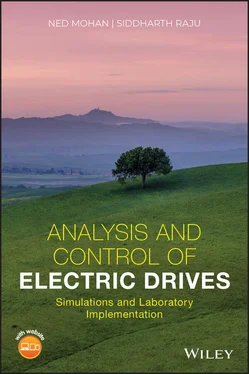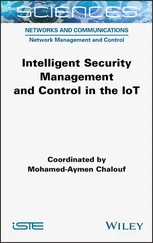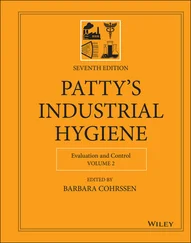s,

r,
T em, AND
ω m 16‐5 CALCULATION OF THE STATOR VOLTAGE SPACE VECTOR 16‐6 DIRECT TORQUE CONTROL USING
dq ‐AXES 16‐7 SUMMARY REFERENCE FURTHER READING PROBLEMS TEST MACHINE 16‐A APPENDIX 17 Vector Control of Permanent‐Magnet Synchronous Motor Drives17‐1 INTRODUCTION 17‐2
dq ‐ANALYSIS OF PERMANENT‐MAGNET SYNCHRONOUS MACHINES 17‐3 NON‐SALIENT POLE SYNCHRONOUS MACHINES 17‐4 SALIENT‐POLE SYNCHRONOUS MACHINES 17‐5 HARDWARE PROTOTYPING OF VECTOR CONTROL OF SPM SYNCHRONOUS MOTOR 17‐6 SUMMARY REFERENCES PROBLEMS 17‐A APPENDIX 18 Reluctance Drives: Stepper‐Motors and Switched‐Reluctance Drives18‐1 INTRODUCTION 18‐2 THE OPERATING PRINCIPLE OF RELUCTANCE MOTORS 18‐3 STEPPER‐MOTOR DRIVES 18‐4 SRM DRIVES 18‐5 INSTANTANEOUS WAVEFORMS 18‐6 ROLE OF MAGNETIC SATURATION [1] 18‐7 POWER ELECTRONIC CONVERTERS FOR SRM DRIVES 18‐8 DETERMINING THE ROTOR POSITION FOR ENCODER‐LESS OPERATION 18‐9 CONTROL IN MOTORING MODE 18‐10 SUMMARY/REVIEW QUESTIONS REFERENCE FURTHER READING PROBLEMS
10 INDEX
11 End User License Agreement
1 Chapter 2 TABLE 2-1 Drag Force and the Power Required TABLE 2-2 Torque–Current Analogy
2 Chapter 5TABLE 5-1 dc‐Motor Drive System
3 Chapter 15TABLE 15-1 Various Operating Modes of DFIG
4 Chapter 16TABLE 16-1 Effect of Voltage Vector on the Stator Flux‐Linkage Vector in Sect...
1 Chapter 1 Fig. 1-1 Block diagrams of (a) electric machines and (b) electric drives (mo... Fig. 1-2 Electric drive for wind generators. Fig. 1-3 Primary energy consumption by end‐use sector in the United States i... Fig. 1-4 Traditional and ASD‐based flow control systems. Fig. 1-5 Energy usage in (a) residential sector and (b) commercial sector. Fig. 1-6 Need for controlling the electromagnetic torque T em. Fig. 1-7 Power and speed range of electric drives. Fig. P1-5 Plot of C pas a function of λ [6].
2 Chapter 2 Fig. 2-1 Block diagram of adjustable speed drives. Fig. 2-2 (a) Electric drive system and (b) example of a load‐speed profile r... Fig. 2-3 Motion of a mass M due to the action of forces. Fig. 2-4 (a) Pivoted lever and (b) holding torque for the lever. Fig. 2-5 Torque in an electric motor. Fig. 2-6 Calculation of the inertia, J cyl, of a solid cylinder. Fig. 2-7 Motor and load torque interaction with a rigid coupling. Fig. 2-8 Speed, torque, and angle variations with time. Fig. 2-9 Torque, work, and power. Fig. 2-10 Actual and linearized friction characteristics. Fig. 2-11 Motor and load‐torque interaction with a rigid coupling. Fig. 2-12 Electrical analogy: (a) shaft of finite stiffness and (b) shaft of... Fig. 2-13 (a) Electrical equivalent and (b) torque and speed variation. Fig. 2-14 Combination of rotary and linear motion. Fig. 2-15 Gear mechanism for coupling the motor to the load. Fig. 2-16 (a) Electric drive and (d) four-quadrant operation. Fig. P2-10 Lead‐screw system.
3 Chapter 3 Fig. 3-1 (a and b) Magnetic field and (c) Ampere’s Law. Fig. 3-2 Toroid. Fig. 3-3 B‐H characteristics of ferromagnetic materials. Fig. 3-4 Toroid with flux ϕ m. Fig. 3-5 Magnetic structure with air gap. Fig. 3-6 Coil inductance. Fig. 3-7 Rectangular toroid. Fig. 3-8 Voltage polarity and direction of flux and current. Fig. 3-9 Waveforms of flux and induced voltage. Fig. 3-10 Voltage, current, and flux. Fig. 3-11 (a) Magnetic and leakage fluxes and (b) equivalent representation ...Fig. 3-12 (a) Circuit representation and (b) leakage inductance separated fr...Fig. 3-13 Motor construction: (a) “cut” perpendicular to the shaft‐axis and ...Fig. 3-14 Structure of machines.Fig. 3-15 Production of a magnetic field.Fig. 3-16 Electric force on a current‐carrying conductor in a magnetic field...Fig. 3-17 Figure for Example 3-9.Fig. 3-18 Conductor moving in a magnetic field.Fig. 3-19 Figure for Example 3-10.Fig. 3-20 Motoring mode.Fig. 3-21 Regenerative braking mode.Fig. 3-22 Power losses and energy efficiency.Fig. P3-9 Problem 3‐9.Fig. P3-10 Problem 3‐10.Fig. P3-11 Problem 3‐11.Fig. P3-12 Problem 3‐12.Fig. P3-13 Problem 3‐13.Fig. P3-14 Problem 3‐14.Fig. P3-15 Problem 3‐15.Fig. P3-16 Problem 3‐16.Fig. P3-17 Problem 3‐17.
4 Chapter 4Fig. 4-1 Voltage‐link system.Fig. 4-2 Switch mode converters for (a) dc‐ and (b) ac‐machine drives.Fig. 4-3 Switching power‐pole as the building block in converters.Fig. 4-4 PWM of the switching power‐pole.Fig. 4-5 Bidirectional power flow through a switching power‐pole.Fig. 4-6 Bidirectional switching power‐pole.Fig. 4-7 Switching‐cycle‐averaged representation of the bidirectional power‐...Fig. 4-8 Waveforms for PWM in a switching power‐pole.Fig. 4-9 Switching power‐pole and its duty‐ratio control.Fig. 4-10 Harmonics in the output of a switching power‐pole.Fig. 4-11 Converter for a dc‐motor drive.Fig. 4-12 Switching‐cycle‐averaged representation of the converter for dc dr...Fig. 4-13 Gain of the converter for dc drives.Fig. 4-14 Switching voltage waveforms in a converter for dc drive.Fig. 4-15 Currents defined in the converter for dc‐motor drives.Fig. 4-16 Superposition of dc and ripple‐frequency variables.Fig. 4-17 Switching current waveforms in Example 4-3.Fig. 4-18 Waveforms of a switching power‐pole to synthesize low‐frequency ac...Fig. 4-19 Three‐phase converter.Fig. 4-20 Switching‐cycle‐averaged output voltages in a three‐phase converte...Fig. 4-21 Switching‐cycle‐averaged voltages due to Sine‐PWM.Fig. 4-22 Switching waveforms in Example 4-4.Fig. 4-23 MOSFET characteristics.Fig. 4-24 IGBT symbol and characteristics.Fig. 4-25 Block diagram of a gate‐drive circuit.Fig. 4-26 Real‐time full‐bridge converter pulse‐width modulation.Fig. 4-27 Full‐bridge converter output voltage and output current.
5 Chapter 5Fig. 5-1 Feedback‐controlled drive.Fig. 5-2 Exploded view of a dc motorFig. 5-3 dc motor equivalent circuit.Fig. 5-4 (a) Torque‐speed characteristics and (b) V aversus ω m.Fig. 5-5 Simplified control system representation.Fig. 5-6 (a) Phase margin and (b) bandwidth.Fig. 5-7 (a) Gain magnitude of a first‐order system open loop, (b) the gain ...Fig. 5-8 Cascade control of a motor drive.Fig. 5-9 (a) Switch‐mode converter for motor drives, (b) average model of th...Fig. 5-10 dc motor and mechanical load: (a) equivalent circuit and (b) block...Fig. 5-11 PI controller.Fig. 5-12 Design of the torque control loop.Fig. 5-13 Frequency response of the current loop: (a) open loop and (b) clos...Fig. 5-14 Block diagram of the speed loop.Fig. 5-15 Speed loop response: (a) open loop and (b) closed loop.Fig. 5-16 Block diagram of position loop.Fig. 5-17 Position loop response: (a) open‐loop and (b) closed loop.Fig. 5-18 Control system with feed‐forward.Fig. 5-19 (a) Limits on the PI controller and (b) PI with anti‐windup.Fig. 5-20 Real‐time dc motor speed control.Fig. 5-21 Hardware speed control.Fig. P5-12 Speed controller.
6 Chapter 6Fig. 6-1 Magnetic axes of the three phases in a 2‐pole machine.Fig. 6-2 Sinusoidally distributed winding for phase‐ a .Fig. 6-3 Calculation of air gap field distribution.Fig. 6-4 Developed view of the field distribution in the air gap.Fig. 6-5 Paths corresponding to Example 6-1.Fig. 6-6 Phase a of a 4‐pole machine.Fig. 6-7 Three‐phase windings.Fig. 6-8 Waveforms of flux density.Fig. 6-9 Representation of MMF space vector in a machine.Fig. 6-10 (a) Resultant flux‐density space vector and (b) flux‐density distr...Fig. 6-11 (a) Phase voltages and currents and (b) physical interpretation of...Fig. 6-12 (a) Stator current space vector and (b) the equivalent winding.Fig. 6-13 Phase components of a space vector.Fig. 6-14 (a) Windings, (b) magnetizing currents, and (c) rotating mmf space...Fig. 6-15 Example 6-7.Fig. 6-16 Relationship between space vectors and phasors in balanced sinusoi...Fig. 6-17 Winding current and induced emf: (a) individual windings, (b) phas...Fig. 6-18 Example 6.8.
Читать дальше

 r, T em, AND ω m 16‐5 CALCULATION OF THE STATOR VOLTAGE SPACE VECTOR 16‐6 DIRECT TORQUE CONTROL USING dq ‐AXES 16‐7 SUMMARY REFERENCE FURTHER READING PROBLEMS TEST MACHINE 16‐A APPENDIX 17 Vector Control of Permanent‐Magnet Synchronous Motor Drives17‐1 INTRODUCTION 17‐2 dq ‐ANALYSIS OF PERMANENT‐MAGNET SYNCHRONOUS MACHINES 17‐3 NON‐SALIENT POLE SYNCHRONOUS MACHINES 17‐4 SALIENT‐POLE SYNCHRONOUS MACHINES 17‐5 HARDWARE PROTOTYPING OF VECTOR CONTROL OF SPM SYNCHRONOUS MOTOR 17‐6 SUMMARY REFERENCES PROBLEMS 17‐A APPENDIX 18 Reluctance Drives: Stepper‐Motors and Switched‐Reluctance Drives18‐1 INTRODUCTION 18‐2 THE OPERATING PRINCIPLE OF RELUCTANCE MOTORS 18‐3 STEPPER‐MOTOR DRIVES 18‐4 SRM DRIVES 18‐5 INSTANTANEOUS WAVEFORMS 18‐6 ROLE OF MAGNETIC SATURATION [1] 18‐7 POWER ELECTRONIC CONVERTERS FOR SRM DRIVES 18‐8 DETERMINING THE ROTOR POSITION FOR ENCODER‐LESS OPERATION 18‐9 CONTROL IN MOTORING MODE 18‐10 SUMMARY/REVIEW QUESTIONS REFERENCE FURTHER READING PROBLEMS
r, T em, AND ω m 16‐5 CALCULATION OF THE STATOR VOLTAGE SPACE VECTOR 16‐6 DIRECT TORQUE CONTROL USING dq ‐AXES 16‐7 SUMMARY REFERENCE FURTHER READING PROBLEMS TEST MACHINE 16‐A APPENDIX 17 Vector Control of Permanent‐Magnet Synchronous Motor Drives17‐1 INTRODUCTION 17‐2 dq ‐ANALYSIS OF PERMANENT‐MAGNET SYNCHRONOUS MACHINES 17‐3 NON‐SALIENT POLE SYNCHRONOUS MACHINES 17‐4 SALIENT‐POLE SYNCHRONOUS MACHINES 17‐5 HARDWARE PROTOTYPING OF VECTOR CONTROL OF SPM SYNCHRONOUS MOTOR 17‐6 SUMMARY REFERENCES PROBLEMS 17‐A APPENDIX 18 Reluctance Drives: Stepper‐Motors and Switched‐Reluctance Drives18‐1 INTRODUCTION 18‐2 THE OPERATING PRINCIPLE OF RELUCTANCE MOTORS 18‐3 STEPPER‐MOTOR DRIVES 18‐4 SRM DRIVES 18‐5 INSTANTANEOUS WAVEFORMS 18‐6 ROLE OF MAGNETIC SATURATION [1] 18‐7 POWER ELECTRONIC CONVERTERS FOR SRM DRIVES 18‐8 DETERMINING THE ROTOR POSITION FOR ENCODER‐LESS OPERATION 18‐9 CONTROL IN MOTORING MODE 18‐10 SUMMARY/REVIEW QUESTIONS REFERENCE FURTHER READING PROBLEMS











